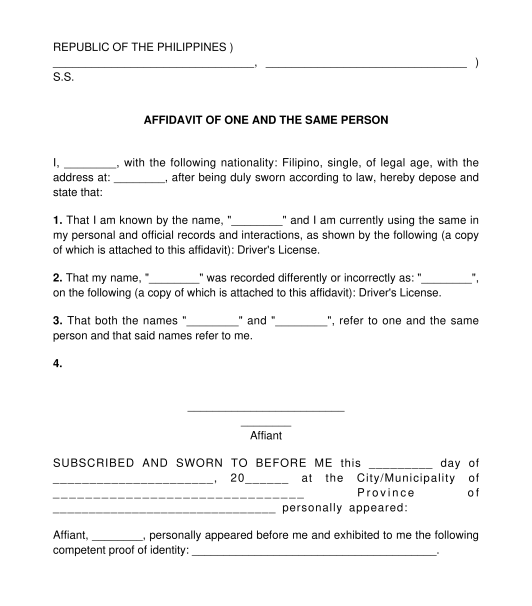 10/07/2025
10/07/2025

Answer a few questions and your document is created automatically.

Your document is ready! You will receive it in Word and PDF formats. You will be able to modify it.




Rating: 4.7 - 66 votes
Fill out the templateAn Affidavit of One and the Same Person is a written document that establishes that two different names found on different documents refer to one person, the Affiant.
The Affidavit of One and the Same Person is usually used when a person knows or discovers that a document contains a name different from the one that he or she currently uses. The difference can be due to the following:
An Affidavit of One and the Same Person is used to prove that the different names found in two or more documents refer to one and the same person. This may be needed for the following:
An Affidavit of One and the Same Person is a document that serves as the sworn statement of the person who has different names in different documents, on the other hand, an Affidavit of Two Disinterested Persons is a document that is used to support the narrations in an Affidavit of One and Same Person.
If the affiant seeks to correct the records in a particular government office or private institution, he must have an Affidavit of One and the Same Person. These organizations usually require an Affidavit of One and the Same Person and an Affidavit of Two Disinterested Persons.
It should be the person who knows or discovers that a document bearing a name different from the one that he currently uses.
If the Affiant is a minor, his guardian should accompany the Affiant to the notary public and sign the affidavit.
The guardian should be either the parent, in the absence or incapacity of the parents, the court-appointed guardian, or persons exercising substitute parental authority over the Affiant, in that order. Persons exercising substitute parental authority the surviving grandparent, the oldest brother or sister, over 21 years old, or the child's actual custodian over 21 years of age, in that order.
Once the affidavit has been completed, at least 2 copies of the affidavit must be printed. Each copy should have the attachments mentioned above. The Affiant must personally appear before a notary public and present at least one current identification card (I.D.) issued by an official agency bearing the photograph and signature of the Affiant. The Affiant must swear under oath the whole truth of the contents of the affidavit and then sign all copies of the affidavit. If the Affiant is a minor, the Affiant must be accompanied by a parent or a guardian when signing the affidavit. The guardian must also sign the affidavit. The Affiant will be asked to leave one original copy for the files of the notary public. Once notarized, the Affiant may use the Affidavit as needed.
The following documents should be attached to the Affidavit:
Yes, because an Affidavit of One and the Same Person is a sworn statement stating that two names are stated differently in different documents and should be used or signed in the presence of a notary public.
Notarization fees for an Affidavit are typically PHP100 to PHP500.
The affidavit includes the following:
There are no laws outlining the contents of an Affidavit of One and the Same Person. However, affidavits are governed by the 2004 Rules on Notarial Practice. It should also be noted that making untruthful statements in a notarized affidavit may be punishable under the Revised Penal Code of the Philippines.
You fill out a form. The document is created before your eyes as you respond to the questions.
At the end, you receive it in Word and PDF formats. You can modify it and reuse it.
Guides to help you
Affidavit of One and the Same Person - sample template
Country: Philippines